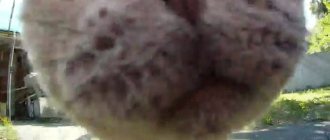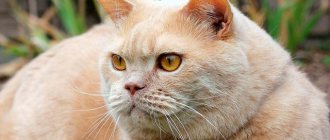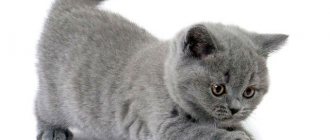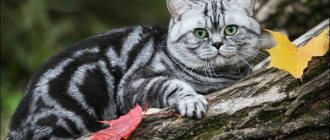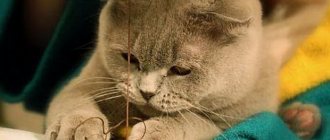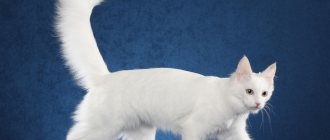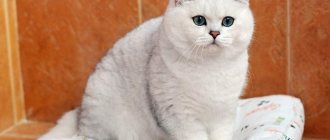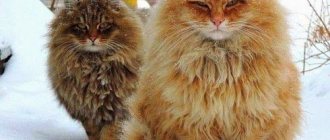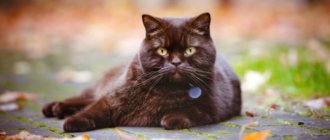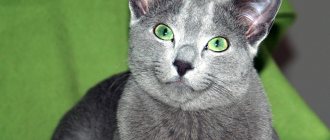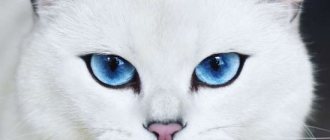The British cat is very popular all over the world. She attracts with her sweet and at the same time majestic appearance. The fur of British cats is plush and soft to the touch. There are two types of British cats: British Shorthair and British Longhair. In the article we will talk about the characteristics of this breed, the history of its origin, care and maintenance.
British cat: description of the breed
History of the origin of the British Shorthair cat breed
The history of the British Shorthair began many centuries ago. It’s nice to think that the country of origin of the British is Great Britain. However, the ancestors of the British were popular back in Roman times. Back then, pets were valued for their hunting instinct. They saved crops and protected houses from small rodents. Back then they were distinguished by their elegance and thin legs.
The breed in its modern sense originated in the 19th century. Then wild relatives significantly improved the gene pool of the British. Until the 19th century, the British cat was formed under the guidance of nature itself. As a result, after several centuries we have a pretty, well-proportioned animal. If their development history were brief, then their appearance would be simpler.
From Great Britain the pet began to be transported to different parts of the world, and so the cat spread throughout the world.
Interesting!
It is believed that it was the Romans who brought cats to the British Isles. According to another version, the British came to Europe during the Crusades, and came to England with French sailors.
The first official cat show took place in 1871. It was organized by a man named Harrison Ware. The next thing he did was develop a rating system, convene the participants and agree on the venue. The morning after the exhibition, the newspapers were full of photographs of British aristocratic cats. This is how British cats gained their first popularity. A little later, a generally accepted breed standard and the first official kennels appeared.
Interesting!
The breed is rarely found in the United States, but in the UK it occupies a leading position in popularity.
After the Second World War, most of the purebred British disappeared. To restore the population, cats began to be crossed with Russian Blue cats and Persians. For a long time, official phenological organizations did not want to recognize the new breed due to mixed blood. However, in 1970 they were recognized by the ACFA, and in 1980 by the CFA. In the same 1980, British dogs were brought to Moscow.
Black pages of history
Alas, the glorious history of the British breed is overshadowed by a black streak. Like other cats that lived in Europe, British tailed cats were subjected to severe persecution in the Middle Ages. They were declared minions of the devil, burned at the stake and subjected to the most sophisticated tortures.
People who were disliked by the intriguers also suffered along with them. Thus, in 1307, the bishop of the city of Converti was accused of worshiping a black cat, and during the trial, this accusation extended to members of the Templar Order.
However, everything comes to an end someday, and fortunately, bad things too. Already in the 30s of the 17th century, the writer Daniel Defoe noted that it was a rare English family that did not keep a cat. And how could it be otherwise - the devil is the devil, but someone has to catch the rodents!
Appearance of the British Shorthair cat
The British shorthair cat has a description that cannot be compared with artificially bred breeds. Nature itself worked on her, so she is perfect from the top of her head to the tip of her tail.
The breed standard helps determine the pedigree of an animal. A brief description can be presented as follows - a large head, chubby cheeks and thick paws.
Height and weight
Medium sized cats. Females weigh 5-6 kg. Males gain weight up to 7-9 kg. The pet gains its final weight by the age of 3-4 years. Representatives of this breed are prone to gaining excess weight. Height at the withers is 28-33 cm.
Length and shape of limbs
The paws are massive and short. The fingers are plump and close tightly. The pads are soft. The tail is thick. The tail is of medium length and has a rounded tip.
Head
The head is round. The main feature is voluminous cheeks. The forehead is rounded. The transition from the forehead to the nose is weakly expressed. The nose is short. Ears with rounded tips are set wide apart. The ears have a wide base and no tufts at the end. The chin is strong and strong.
Important!
Real British cats are always straight-eared. Only Scottish cats have fold ears.
Eye color and shape
The eyes are large and set far apart. The eyelids are round in shape. The color of the iris is yellow, blue or green. White Britons have eyes of different shades (heterochromia).
Wool
The fur seems plush. It makes British cats look like bear cubs. If a kitten is born in the described breed with inappropriate fur, this is considered a defect.
Plush fur appears due to the same length of guard hair and undercoat. The hairs are short and set tightly. The undercoat is thick. The fur is close to the body. Some owners trim the fur short to create an even cuter appearance. Partly due to their beautiful fur, cats have gained popularity.
Interesting!
There is a longhaired breed of British cats that was previously considered a low category.
Constitution
The British have a strong body, a powerful body of medium size. The neck is short. There are folds on the stomach and neck. The chest is wide. The back is straight. The belly can sag as you age. Overall the body is proportional. Characterized by rounded lines and smooth outlines of the figure. Despite its cute appearance, this is a strong animal.
Voice
Cats have a medium-loud voice. It is quite gentle, a little husky. Some individuals love to talk, especially at night. The rest of the time they prefer not to pester the owner. Kitties can sing long, drawn-out songs during heat.
Possible defects
Animals with defects are not allowed for breeding and do not receive first places at exhibitions. However, external flaws do not affect the love of the owners in any way.
Common defects:
- skeletal deformities;
- strabismus, blindness or deafness;
- Fold-eared kittens are also a defect; the British have straight ears;
- malocclusion;
- spots on a solid color, unclear stripes on tabbies, violations of color standards;
- knots or kinks in the tail;
- aggressive behavior.
Buyers who purchase a pet for a show career should know the description of all defects. If the breeder officially registers the animals, he receives a message about deviations in appearance.
Interesting!
Externally, the British have a common description with the Chartreuse breed. Only professionals can tell them apart. They differ in head, coat color (chartreuse has a deeper gray), and habits.
Coat color
Thanks to the work of breeders, more than 30 shades of wool are known that are found in British Shorthairs. Color information is still changing.
Plain
The British shorthair cat is in particular demand. Brief description – plain fur without spots, stripes, or hairs of a different color. In general, there are 7 variations of solid colors in the breed, including cream, chocolate, white, black, lilac, red and red.
Tortoiseshell
The coat combines 3 different shades, often with one of them being dominant. Each tortoiseshell color is unique, it is impossible to find 2 identical colors. Officially, there are only 80 color variations.
Chinchilla
Chinchilla is a favorite color of many breeders. The attractiveness of the smoky color can be assessed from the photo. It appeared relatively recently, but quickly won love among buyers. This is an expensive color and difficult to breed. The gold variety is in demand, but there is also a silver variety. The main characteristic of the colors is soft tones.
Important!
The golden variety is crossed only with the golden color.
Tabby
Tabby cat is a brindle color. Tiger stripes stand out clearly against the main, lighter background. The striped coloring can be presented in black and silver or in a brownish-red shade. The Whiskas advert featured just such a tabby kitten. There is a marbled type of fur, when the stripes turn into various patterns.
Bicolor
The main thing in describing the color is the combination of 2 different shades. Gray and white, which is shown in the photo, is common. At the same time, it unevenly covers the fur, forming various spots. Often the paws are dressed in white socks, sometimes the tail is highlighted.
The hair grows short, which creates the feeling of plush fur. There are tricolor colors, where 3 shades are combined at once. For example, a combination of gray, red and white.
Color Point
The British Shorthair cat is distinguished by an abundance of colors. There is even a Siamese color point. In another way, the color is usually called the Himalayan color. The main feature is the contrast of color spots. The main color of the coat should be light, and the mask on the face, ears, tail and paws should be dark.
Breed description, standard
The British cat is distinguished by its strong build, plush coat, and great physical strength. Britons are heavyweights among domestic cats. This breed is brachycephalic - having a round head with a short nose. The roundness and power of the head is emphasized by developed cheeks. Well-filled whisker pads and chin create the effect of the famous “Cheshire cat smile.” Representatives of the British breed have especially pronounced sexual dimorphism - males differ significantly from females. Cats are much more massive, larger, their weight often reaches 10-12 kg. Cats have a more modest body weight - 5-7 kg, and their cheeks are less pronounced.
Table – Breed standards of British cats
| Head | Large, round, with a powerful short neck. The full face forms a regular circle. The profile is shortened due to the nose, there is a fairly pronounced transition between the bridge of the nose and the forehead, and a flat area between the ears. Well-stuffed underarms and cheeks, a strong chin. |
| Ears | Widely spaced, short, on a wide base. |
| Eyes | Round, color (orange, green or blue) depends on the color variant. |
| Torso | The size is medium to large, with a massive chest, scapular region, and back. |
| Paws | Powerful, short. |
| Tail | Short, almost the same diameter along the entire length, without a point at the end. |
| Wool | Plush - soft, thick, dense, not adjacent to the skin. |
The table shows the main averaged parameters. Each feline system has its own nuances of British breed standards.
Colors of British cats
Representatives of the British breed can have almost any color variant that exists among domestic cats.
Table - Main color types of British cats
| Solid (plain, solid) | Classic colors - blue and lilac Less common are black, white, chocolate, red, pink. Rare - cinnamon, fawn. |
| Patterned (tabby) | Brindle (striped), spotted, marbled. With a pattern of different colors on different backgrounds - gold, silver. |
| Bicolor | Two-color - with spots on a white background. |
| Color point | British cats have an acromelanic color (like Siamese) - with a darker muzzle, paws, ears, tail and blue eyes than the body. |
| Shaded | With different colors along the length of the hair (one of the varieties of this color is chinchilla). |
| Tortoiseshell | Found only in cats - a combination of black and red in different tones. |
Breed faults
Breed defects are shortcomings in the pet's exterior. Representatives of the British breed with minor similar defects can participate in breeding, but do not receive top marks at exhibitions. Males and cats with severe deficiencies cannot participate in breeding, while remaining charming and attractive pets. Such disadvantages include:
- too light bones, thin and long paws, tail;
- weak chin, poorly defined cheeks;
- too short and snub-nosed or, conversely, long nose;
- close-set, elongated ears;
- white spots on a solid or point coat;
- aggressive or cowardly behavior.
British cat with heterochromia
How do British cats differ from Scottish cats?
British and Scottish cats have certain similarities and are often confused. However, these are two different breeds, interbreeding between their representatives is not encouraged. Kittens from such matings are considered outbred by most felinological systems. Therefore, there are no “British Fold” cats in the felinological world. Fold cats and cats with obvious signs of the British breed are mestizos of British and Scottish parents, the fruits of interbreed matings that are not recognized as purebred animals. These are cute pets, but they are not suitable for further breeding.
Table - Main differences between British and Scottish cats
| Part of the body | British cat | Scottish cat |
| Head | Round, with pronounced cheekbones, chin, and underarms. A sharper transition from the nose to the forehead than the Scots. | The shape of the head in profile is smoother, more rounded than that of the British, the forehead is somewhat steeper. Full face - a more pronounced pinch (the transition between the cheekbones and mustache pads). The face of the Scottish cat is very reminiscent of an owl. |
| Ears | Always straight, widely spaced, rounded. | Straits (straight ears) have narrower, pointed, closer ears than the British. In Scottish Folds (Scottish Fold), the ears are tilted forward, ideally pressed to the head. |
| Frame | Cobby-type cats are stocky, muscular cats with strong, wide bones. | Less “compact” animals with a more elongated, “light” body. |
| Paws | Short and thick. | Longer, medium thickness. |
| Tail | Short, thick, rounded at the end. | Long, medium thickness, pointed. |
| Character and temperament | They are quite phlegmatic, not inclined to play a lot, and often communicate with other animals and people. They rarely tolerate fellow tribesmen in the house. | More active than the British, they love communication with people and pets more, and get along more easily with their relatives. |
Characteristics and habits
The British Shorthair cat has a calm and kind character. These are affectionate and peaceful creatures. At the same time, they also have bright character traits that do not let their owners get bored.
Attitude towards people, children, animals
The British are kind to children and often take part in joint games. They will make a wonderful friend and children's companion. Cats practically do not show aggression. However, cats do not tolerate disrespect, so children should be taught basic animal communication skills.
Cats become attached to their owners, so it is not recommended to transfer them to other hands throughout their lives. They follow their owner everywhere and even sleep in his bed.
Pets are suitable for single people. During the daytime, cats prefer to sleep, so they easily cope with the absence of their owner.
The British have a positive attitude towards other pets. In the worst case, they will maintain neutrality, but will not divide the territory. However, if the cat is not neutered, then a conflict will still arise.
Interesting!
It is believed that this particular breed is represented in the fairy tale “Puss in Boots”.
Calm and aristocratic
The British Shorthair cat has a balanced character. These are loving and calm pets. Cats have refined manners, as befits aristocrats.
They have their own inner world. They don’t get right in the owner’s face and never just demand attention. They have feelings of tact and empathy. They understand human intonation.
One of the main characteristics of the British is cleanliness. They don’t make a mess, and are extremely worried if something goes wrong. The British, like people, prefer to live in good, quiet conditions.
Interesting!
Their aristocratic, imposing and capricious nature excludes the possibility of training. A pet can only be trained to use a tray and a scratching post.
Lifestyle
The main thing in describing their character is their calm disposition and kindness. Cats don't make much noise. They like to lead a calm and correct lifestyle. They mostly sleep during the day. They can run around the apartment at night. They are especially active during periods of maturation - in the first 2 years of life.
These are extremely independent animals. They will not bother their owners without reason. They play, relax, and sleep on their own. They can only actively demand a packet of food.
The British Shorthair cat breed is not known for its playfulness. The maximum time spent playing with the owner is 1-1.5 hours. With age, the desire for activity is replaced by a greater desire to sleep. Already at 3-4 years old, pets are nocturnal and sleep 80% of their time.
Russian nurseries
On a professional basis, they are engaged in breeding British breeds of the prototype of the fabulous Cheshire cat in nurseries in several regions:
- Village Zeleny, Moscow region “SunRay”
- Moscow "Wonder Plush"
- Moscow "Miracle Cats"
- Vladivostok "Galeksy"
- Krasnodar “Steppe Stars *RUS”
- Ekaterinburg "Silver Shine"
Care and maintenance
British cats, although unpretentious, still need hygienic and medical procedures.
Moving into a new home
A new home needs a basic set of items:
- The first thing you need to arrange is a sleeping place. It should be warm, cozy and dry. A store-bought bed or a regular warm blanket that can be spread on the sofa will do.
- The tray is installed in a quiet but accessible place. It is better to use wood filler. It absorbs odors well, has a low price, and can be changed every 1-2 days. British aristocrats cannot relieve themselves in a dirty pan.
- Carrying required. It is used for travel and trips to the veterinarian.
- Food area. A bowl for water, a bowl for dry food, and a bowl for wet food or treats are a must. The water is changed daily.
- A scratching post is a necessary attribute of any predator. Without it, the pet will still sharpen its claws, only on furniture.
- Claw cutter. Needed for trimming claws.
- You will need a number of toys. Information from the breeder will help you choose toys in accordance with the kitten’s character.
Important!
The environment surrounding cats should be safe, clean and comfortable.
Hygiene and medical procedures
There are several rules of care:
- British breeds require weekly brushing. They shed regularly (usually in spring and autumn), but even without shedding they lose a lot of hair, which does not make their owners happy. The procedure helps maintain a well-groomed appearance and protects pets from swallowing fur.
- Bathing is carried out once every 3 months, or better yet, 1-2 times a year. The British are very clean, so they can easily do without water procedures. When washing, use a special cat shampoo.
- Nails are trimmed every 15-20 days. This relieves the animal from discomfort and protects the furniture from scratches. Use a special nail clipper. Conventional scissors delaminate the plate and cause injuries.
- It is recommended to regularly examine your pet's oral cavity. Teeth brushing is carried out at least once a week. This will protect cats from tartar.
Important!
Owners will need to get sticky rollers and a good vacuum cleaner to get rid of cat hair more thoroughly. Even combing does not protect the house from fur.
Basic medical procedures:
- From the age of 3 months, British kittens begin to be vaccinated. Vaccinations protect against infectious diseases. Revaccination is carried out once a year.
- From 7-10 months it is recommended to carry out sterilization and castration. The operation is painless. It prolongs the life of the animal and protects it from stress.
- Every season a preventative treatment for worms and fleas is carried out.
Information about other procedures is provided by your personal veterinarian.
Diet
British people have a good appetite, so they have a tendency to gain excess weight.
Important!
The British are very picky eaters, it is important to take into account their tastes. Some people won't eat dry food even if you starve them.
British cats should not be fed cheap dry food such as Kitekat and Whiskas. From such food they will develop problems with digestion, the genitourinary system, and hair will come out. It is safer to use premium brands or holistic food.
List of popular brands of dry food:
- Royal Canin;
- AATU;
- Acana;
- Bozita;
- Savarra, etc.
They have a rich composition and a good vitamin and mineral complex.
Some owners take full responsibility for the animal’s diet and switch them to natural food.
Natural menu:
- The main diet is meat, at least 80%. This can be turkey, chicken, rabbit, beef, veal and fish. Avoid pork completely; it has a negative impact on health.
- The remaining 20% comes from boiled vegetables, herbs and cereals.
- It is acceptable to occasionally treat your cat with fermented milk products. Low-fat kefir and low-fat cottage cheese are suitable.
- You can give cats boiled eggs.
- It is acceptable to treat your pet with interesting treats, but only those intended for cats.
- Vitamin and mineral supplements are recommended to maintain health. They are selected individually for each pet.
Adults are fed 2-3 times a day. Kittens can eat more often - up to 5 times a day. The environment in the food area must be clean.
Features of British breeding
Like other breed cats, according to standards, British cats are conventionally divided into three classes:
- Show – animals with the best breed characteristics, taking prizes at exhibitions and suitable for breeding work, producing high-quality offspring. Cats participating in breeding can only be show class, otherwise they are castrated and left as pets.
- Breed cats are cats with impeccable health, good pedigree, but with possible minor breed defects. Such British women, like show-class animals, participate in breeding.
- Pets are animals with pronounced breed deficiencies or health problems (cryptorchidism, hernia, and others). Such cats cannot participate in breeding, but make excellent four-legged companions.
The activity of a breeder requires great responsibility from the owner - good care and maintenance of the pet, participation in exhibitions. The exhibition must be visited at least once before the planned mating to determine whether the animal is suitable for breeding. To select the right partner, it is best to join a club - its leader (usually a competent felinologist) will help you choose the best pair to consolidate high breed qualities in the offspring.
Puberty in representatives of the British breed occurs later than in smaller cats - in females at 9-12 months, in males often at 2-3 years. The cat should be bred at the age of no earlier than one year and two months. It is better to make the first mating before 1.5-2 years of age, at the time of the second or third sexual heat. The cat is bred in the cat's territory. It is advisable to produce offspring without compromising the cat’s health no more than 1-2 times a year. Breeding animals are removed from breeding at the age of 6-8 years.
If there is no opportunity or desire to attend exhibitions, tolerate the behavioral characteristics of a stud cat (urine marks and sound), set up a cat “maternity hospital” and care for offspring, it is best to castrate your pet. This will not make him less active and inquisitive, but it will save the owner from many problems. Cats are sterilized up to a year, preferably before the first episode of heat. Males can be castrated much later, at the first signs of maturation (restlessness, interest in the opposite sex).
A full cardiac examination, including an echocardiogram (ultrasound examination of the heart), is strongly recommended for British cats and male cats before neutering. This will help to identify HCM in a timely manner and minimize the risk of anesthetic complications.
The British are very good hunters
Hereditary diseases
The British Shorthair cat has strong immunity. In general their health is good. However, there is information about a tendency to hereditary diseases.
Polycystic kidney disease
This is a genetic kidney disease. Characterized by the formation of cysts on the surface of organs. The first symptoms may appear at 2 years of age. The peak of the disease falls at 7 years of age.
Symptoms:
- lethargy;
- frequent urination;
- strong thirst;
- lack of appetite;
- weight loss;
- nausea and vomiting.
There is no direct treatment for polycystic disease. Medications are prescribed that slow down the growth of cysts and remove associated symptoms.
Important!
If the kitten's parents are healthy and do not have such abnormalities, then the kitten will be healthy.
Cardiomyopathy
The disease consists of an increase in the volume of the heart, thickening of the walls of the heart, or hardening of the heart muscle. Such reasons interfere with normal heart rhythm and lead to a bunch of problems.
For prevention, cats from 5-6 years of age undergo an annual heart ultrasound and collect information about the pet’s condition. If a pet has not acquired the disease before the age of 8, it is not in danger.
List of symptoms:
- lethargy and apathy;
- difficulty breathing and asthma attacks;
- constant shortness of breath;
- low body temperature;
- fainting.
There is no treatment. The veterinarian prescribes a number of medications that significantly alleviate the pet’s situation and prolong its life.
Health and susceptibility to disease
The British are physically strong, healthy pets, their average life expectancy is 15-16 years. However, due to improper breeding, as well as the special structure of the facial skull, this breed is at risk for the following diseases:
- Hypertrophic cardiomyopathy (HCM) is a progressive increase in the thickness of the heart muscle, leading to blockage of the aorta by a blood clot, heart failure, and sudden death.
- Polycystic kidney disease is the gradual replacement of kidney tissue by numerous cysts (cavities), resulting in the development of kidney failure.
- Brachycephalic syndrome - narrowing of the lumen of the nostrils, tortuosity of the lacrimal duct as a result of flattening of the muzzle. It manifests itself as difficulty in nasal breathing and a tendency to watery eyes.
HCM and polycystic kidney disease are incurable hereditary diseases that appear at an early age (sometimes up to a year) and lead to the death of the animal before the age of 6-7 years. Responsible breeders conduct laboratory genetic testing of potential sires for these pathologies, check them annually using ultrasound methods, and do not allow sick animals to be bred. Brachycephalic syndrome in the British is most often mild and does not require treatment - it is enough to wipe the pet’s eyes from time to time. In some cases, surgical correction of the nostrils is performed.
British cats, like representatives of other breeds, require annual comprehensive vaccination against panleukopenia, viral rhinotracheitis and calicivirus, and rabies. Before vaccination, the pet is given a deworming remedy 10-15 days before vaccination. Cats walking outside the house are additionally treated with flea drops and sprays.
Cat and female cat of the British breed
Choosing a kitten, cost
Due to the great popularity of the breed, it is better to choose a kitten from an official cattery. There are many scammers who sell ordinary kittens or crossbreeds under the guise of purebred British ones. There have been cases when long-haired breeds were sold under the guise of short-haired ones, with the hair cut short.
The kitten is taken home at the age of 3 months. During this time, babies learn the necessary skills from their mother, receive their first vaccinations, and become accustomed to the tray.
When purchasing, you should pay attention to:
- cleanliness of floors, trays and bowls;
- lack of characteristic odor of urine;
- inspect the documents for the kitten, the pedigree of the parents;
- ask for information about the baby’s health;
- kitten behavior - it should be active and playful;
- the appearance of the kitten - it must be clean, without bald spots and disturbances in the structure of the skeleton, coordination;
- ears should be straight.
The starting price for a good British kitten starts from 10-15 thousand rubles. The price can reach up to 40-50 thousand rubles.
What does a British cat need in an apartment?
Before bringing your Briton to a new place of residence, prepare all the necessary accessories for him:
- Sleeping area. Decide in advance where your pet will sleep. Representatives of the British breed are quite independent and like to be alone, so it would be advisable to buy your pet its own bed or cat house.
- Tray. For the toilet, it is better to use a closed plastic tray. When purchasing, you should take into account the large dimensions of the British - the tray should be high and as comfortable as possible. It is better to use silica gel or wood filler; they absorb moisture well and prevent the occurrence of unpleasant odors.
- A bowl. A special drinking fountain or ceramic bowl is perfect for water. And for food, you should choose a tall metal bowl with a wide bottom.
- Scratching post. British cats do not want to spoil your furniture at all, they just love freedom very much. However, we all know how dangerous the street is for purebred animals. In order for your pet to be able to independently care for its claws in the apartment, it needs to purchase a scratching post or a play set.
- Comb. For the plush fur coat of the British, massage slicker brushes or oval rubber combs, which can remove static electricity, are best suited.
- Cloth. An additional accessory for your pet can be cool clothes that will not only emphasize the important appearance of the British cat, but will also warm you up during a walk in the cold. After all, short-haired cat breeds have a hard time withstanding frosty winters. Clothing for a British person should be comfortable, high quality and easy to wash.
Create a cozy atmosphere for your pet in your home, and then he will be able to feel at ease.
Breeding the British Shorthair cat
British cats are always bred only with British cats. Since 2006, mating between British and Scottish dogs has been officially banned. If you breed a fold-eared cat with a straight-eared cat, some of the offspring will die.
Color compatibility list:
- golden and silver chinchillas are bred only with golden and silver chinchillas;
- if you mix the black group of colors (black, blue, chocolate) and the red group of colors (cream, red, red), tortoiseshell kittens will be born;
- A striped cat (tabby) should also be bred with a tabby cat, but relaxations are allowed here.
The first mating is carried out when the animals are 1 year old. The compatibility of the blood group is taken into account; if it is negative, the pregnancy will be terminated in the first days. On average, a cat gives birth to 5-6 straight-eared kittens.
Important!
Before mating, it is necessary to check the health of each animal.
Castration and sterilization
If breeding is not planned, the pet undergoes surgery. It is advisable to do it before the first mating, always before the age of 2 years.
Castration and sterilization procedure:
- relieves your pet from stress;
- prolongs its life;
- protects against health problems;
- eliminates the possibility of marked areas in the apartment.
Recovery after surgery takes a matter of days. Within a week the pet will return to its previous lifestyle. During the recovery period, the environment should be virtually sterile and safe.
Pros and cons of the breed
Each breed has its pros and cons. The British cat has a unique character that combines an insane love for people, but does not exclude pride and willfulness.
Advantages of the breed:
- good health;
- friendly and affectionate character;
- independence;
- cleanliness;
- fit well into families with children;
- easy care.
Despite its advantages, the breed has its own small characteristics.
Disadvantages of the breed:
- often overeat and gain weight;
- needs expensive food;
- wayward character, British individuals cannot be trained;
- the pet decides for itself where its personal boundaries lie.
Despite the disadvantages, British cats are still a popular breed. The cat will immediately become a full-fledged member of the family and will delight its owners with its kind character.
Interesting!
The British Shorthair cat ranks 5th in the ranking of the 20 most popular cat breeds in the world.
"Conquest" of the world
Overseas, British cats also went through a difficult journey - the first Briton was exported to America back in 1901, however, the CFA recognized the British Shorthair as an independent breed only in 1980.
Fortunately, today all the misunderstandings are behind us - the British Shorthair breed is recognized by all felinological organizations. There are probably thousands of nurseries where British dogs are bred all over the world. Breeders are working on the emergence of more and more new colors - today British cats can no longer be only blue.
With all this, they retained their best features: the recognizable appearance of respectable aristocrats, excellent health, excellent hunting abilities and a calm, self-possessed character.
Photo and video
Photo:
Video:
Video: British Shorthair cat
Video: British Shorthair - breed overview
Video: British cat - owner’s opinion about the breed
Pure-blooded British people are distinguished by their kindness and sensitivity. These are true partners and true friends. Their maintenance does not require large material costs, and time spent with them gives real happiness.
